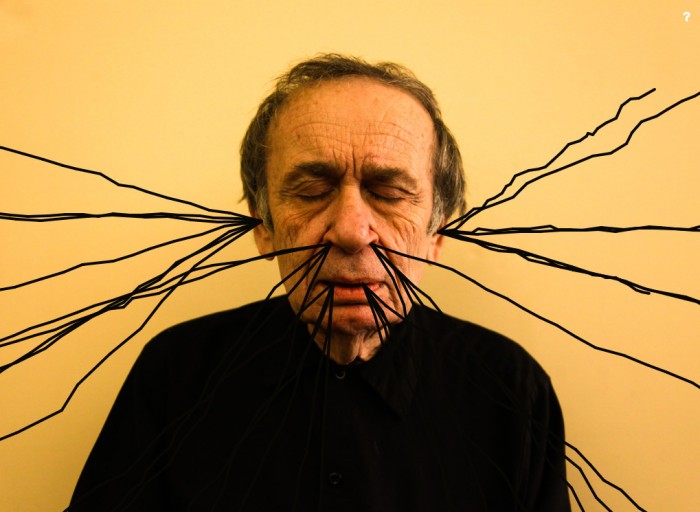
Jonathan Harris explores the relationship between humans and technology, incorporating computer science, statistics, storytelling, visual art, and other techniques to create his work.
Recently he was paired with architect and artist Vito Acconci as part of Bit by Bit hosted by The Brown Institute for Media Innovation at Columbia University. The event explored and reflected on the powerful pairing of story and technology and the roles they play in society. Seven storytellers were paired with seven technologists and challenged to come up with something new.
Vito Acconci is a kind of legendary figure in the art world. In the early 1970s, he made a series of performance art pieces that used his own body as both subject and tool. In Hand and Mouth, he repeatedly forced his fist into his mouth until he gagged. In Trademarks, he bit his own skin, and then made prints from the bite marks left by his teeth. In Seedbed, while visitors walked around an empty gallery above, he hid below the floor, vocalising sexual fantasies and masturbating.
“My early work nearly ruined my career,” Vito told Harris by email, “and also nearly killed me,” he told later him in person. “What does a body artist do as a body grows old? It seemed necessary to find a new direction.”
In the mid-1970s, Acconci stopped doing performances, and turned to architecture, to which he’s been committed ever since.
Instead of being committed to an asylum, I committed myself to architecture, he says in one of the audio fragments that form part of the artwork.
The duo spent two days together struggling to find common ground. “We spent a lot of time talking, but nothing really clicked. I’d throw out ideas, and Vito would veto them. I started to call him Veto Vito. Then, we started talking more about that phrase — Veto Vito — and Vito told me he liked it. He said how, ever since abandoning the performance work, he’s been trying to transcend his own reputation.”
According to Acconci his early works became so famous that it’s been hard for him to be known for anything else.
He’s been doing architecture now for thirty years, but people still know him as the Vito Acconci of 1973, and he’s sick of it. “I want to veto that version of Vito,” he says. “I want to be known for the work I do today.”
To Acconci, work has always been the most important part of life. But a couple weeks before the project, at age 74, he got married, and his feelings have started to change.
“Vito gave me a bunch of his writings to read, and one passage in particular stood out to me. It was Veto saying how a part of him had softened. He was saying how he used to believe that ‘a person travels through the world with tentacles, and when one person joins with another, at least some of those tentacles get entangled, and are no longer free to be alerted to the rest of the world.’ But then he said he doesn’t see it that way anymore. ‘No,’ he wrote, ‘a person does not drive through the world with grabbers. A person drifts through the world, on the verge of a breakup into particles.’”
Harris found these words beautiful and decided use this as the basis for a little portrait of Acconci showing his transformation from tentacles to particles.
The digital portrait called Veto Vito allows the viewer to interact with it and you can also listen to audio fragments of Vito’s beliefs.






